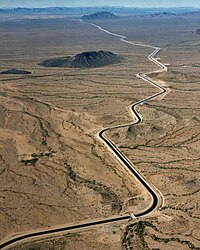Aqueduct (water supply)

An aqueduct is like a big straw that helps us move water from one place to another. Just like how you use a straw to drink your juice, an aqueduct helps move water over long distances so we can use it for things like drinking or bathing.
A long time ago, people realized that they needed water to survive, but their homes and farms were often far away from any sources of water. So, they built aqueducts to help bring the water to where they needed it. Aqueducts can be made out of different materials, like stone or concrete, and can be above or below ground.
The water travels through the aqueduct in a channel or pipe, using gravity to move downhill. Sometimes, the aqueduct needs to go over or under obstacles like hills, valleys, or rivers. To do this, people built arches or bridges to support the aqueduct and keep the water flowing.
Today, we still use aqueducts to move water in many parts of the world. They help us bring clean water to cities and towns, irrigate crops, and produce power through hydroelectricity. So, the next time you drink a glass of water or take a bath, remember that an aqueduct helped bring that water to you!
A long time ago, people realized that they needed water to survive, but their homes and farms were often far away from any sources of water. So, they built aqueducts to help bring the water to where they needed it. Aqueducts can be made out of different materials, like stone or concrete, and can be above or below ground.
The water travels through the aqueduct in a channel or pipe, using gravity to move downhill. Sometimes, the aqueduct needs to go over or under obstacles like hills, valleys, or rivers. To do this, people built arches or bridges to support the aqueduct and keep the water flowing.
Today, we still use aqueducts to move water in many parts of the world. They help us bring clean water to cities and towns, irrigate crops, and produce power through hydroelectricity. So, the next time you drink a glass of water or take a bath, remember that an aqueduct helped bring that water to you!
Related topics others have asked about:
